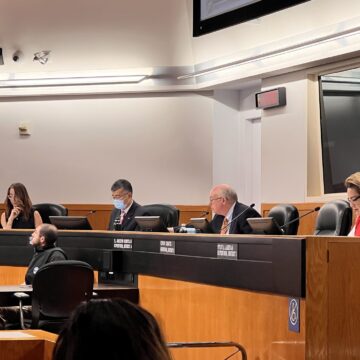County officials want to provide broadband internet service in underserved neighborhoods, contrary to a long-awaited report that dismisses the idea.
The digital equity study, which they commissioned two years ago, warned the Santa Clara County Board of Supervisors against the steep cost of building an underground fiber network and instead suggested partnering with the private sector. That failed to impress supervisors on Tuesday, aligning with residents who said the study ignored neglected households without web access. Supervisors unanimously voted to send the report back to the drawing board and come back in 60 days with a cost and timeline — signaling a willingness to take on the heavy lift of managing an internet utility.
“We don’t expect it to be low cost,” Supervisor Otto Lee said at the meeting. “But now it is a clear necessity. It’s as close to a utility as water and electricity, to survive and function.”
County Supervisor Cindy Chavez spearheaded the discussion about creating a countywide fiber network, or one administered in collaboration with other local government agencies and nonprofits. She called the report “barely adequate” at showing how the county could meet a long-term standard set by the federal government for one gigabit or 500 megabits per second of broadband speed.
Nina D’Amato, chief information officer for the county who oversaw the report, said workers would evaluate how the county could take on providing internet to underserved residents.
“It’s very expensive to become a county broadband provider,” D’Amato said.
The county entered into a $208,000 contract with a consulting firm, CTC Technology and Energy, to help develop an analysis of the idea. The same firm worked with neighboring Santa Cruz County on its own strategic plan for broadband, which county broadband advocates praised for acknowledging the idea’s challenges while still exploring concrete strategies and costs.
“Our strategy does not do that,” Chavez said at the meeting. “We hired the same consultant as Santa Cruz nine months before they did, to develop a broadband master plan, and they got their plan after 16 months.”
A county spokesperson said the technology firm’s work on the study started to compete with work the firm was doing for several other counties and the state. As a result, county employees had to step in and finish the study.
The issue has become more urgent since enrollment discontinued for the federal Affordable Connectivity Program in February, which offered low-income households a discount on their monthly internet bill and a one-time discount off the purchase of a laptop, desktop computer or tablet.
“Thousands across our county have now lost internet access who do not have the means to get on and are not even accounted for in this (report),” Devon Conley, vice president of the Digital Equity Coalition, said at the meeting. “The (report) also focuses on what it calls a concentrated area that has the highest needs (East San Jose, South San Jose and South County). But it only accounts for 28% of the households in need across the county.”
Board President Susan Ellenberg said if funding for the Affordable Connectivity Program is reinstated, there needs to be more thoughtful county outreach to get more people enrolled.
“Santa Clara County had one of the lowest percentages of enrollment by eligible households in the state,” Ellenberg said.
Multiple speakers from a Milpitas-based wireless broadband company, Tarana Wireless, urged against a one-size-fits-all solution to the digital divide.
Officials agreed they can only improve connectivity through a variety of strategies.
Supervisor Sylvia Arenas suggested that a revised report on the digital divide should include options for distributing unused county devices to the community, as well as community Wi-Fi programs that San Jose officials set up around schools like Independence and Andrew P. Hill high schools.
“It’s another affordable way to bring access to free Wi-Fi to folks. But it doesn’t mean they will have access because they may not have the devices,” Arenas said.





